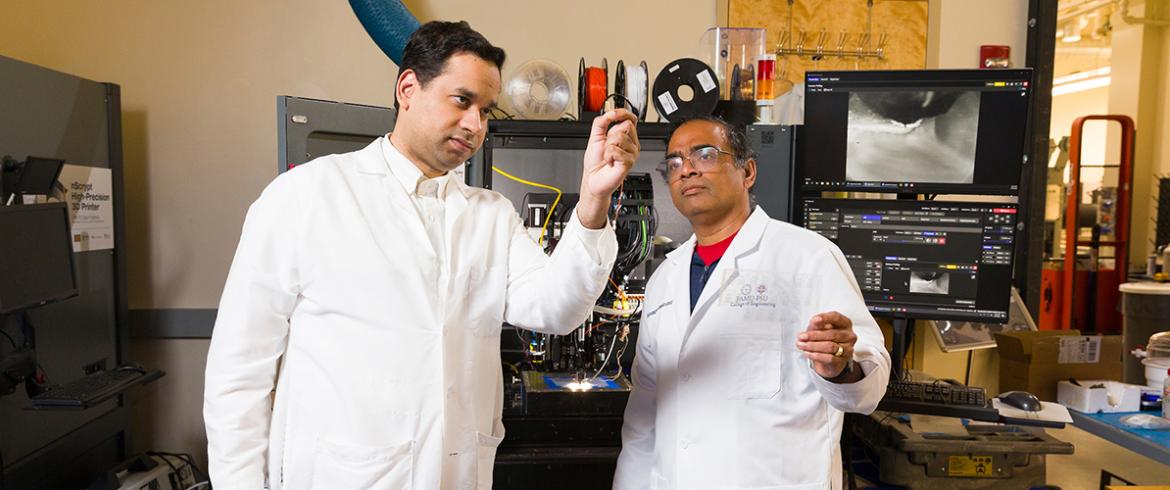
From left, FAMU-FSU College of Engineering faculty members Jamel Ali and Subramanian Ramakrishnan with the nScrypt 3D printer at the High-Performance Materials Institute. Ali and Ramakrishnan will research advanced composite materials and manufacturing technologies critical for future space missions through a NASA grant. (Scott Holstein/FAMU-FSU College of Engineering)
Joint college researchers develop revolutionary materials enabling astronauts to manufacture components during missions
Researchers at the FAMU-FSU College of Engineering are developing breakthrough technologies in advanced 3D printing that could fundamentally transform how astronauts sustain themselves during long-duration space missions. These technologies would enable on-demand manufacturing in the challenging environments of space.
The pioneering work, led by Professor Subramanian Ramakrishnan from the Department of Chemical and Biomedical Engineering, focuses on developing next-generation materials critical for future space exploration and has secured $5 million in NASA funding.
“Imagine while on a space mission having the ability to print sensors, radiation shields, or even functional tissues as the mission progresses,” says Ramakrishnan. “This capability could change the space exploration paradigm, making missions more sustainable and adaptable to unforeseen challenges.”
Advanced Materials for In-Space Manufacturing
Ramakrishnan’s team focuses on creating innovative materials for in-space manufacturing (ISM), developing unique 2D materials called MXenes along with metallic and semiconducting nanoparticles to create specialized inks for 3D printing in extraterrestrial environments.
“These advanced inks are used to print everything from sensors that detect gases and strain, to antennas, radiation shielding and flexible electronic circuits,” Ramakrishnan said. “They are especially important for 3D printed materials used on space missions.”
The vision for in-space manufacturing is transformative—empowering astronauts to produce what they need while in orbit, dramatically reducing reliance on Earth-supplied materials and enhancing mission sustainability.
These distinctive materials possess exceptional structural, physical and chemical properties, making them ideal candidates for various applications including energy storage, sensors, optoelectronics and biomedical uses. Their importance extends beyond space exploration to specialized materials applications on Earth.
Utilizing Extraterrestrial Resources
One of the most promising innovations involves utilizing lunar and Martian soil—known as regolith—to create specialized inks that can be 3D printed into functional structures for future Moon and Mars missions. This approach transforms local extraterrestrial resources into valuable construction materials, potentially enabling sustainable habitation on other worlds.
The interdisciplinary team collaborating on this research includes Satyanarayan Dev from FAMU's Department of Biological Systems Engineering, Richard Liang from Florida State University and the joint college, Emily Pritchard from the FSU Office of the Provost, and Margaret Samuels from NASA’s Goddard Space Flight Center.
“This system has the critical capability for us to complete the manufacturing of precise sensor patterns (both sensing materials patterns and electrode and connection patterns) in a single step to ensure high-quality of device integration and on-demand design and manufacturing,” Ramakrishnan explained.
Innovative Printing Methodologies
The researchers have developed a novel technique called electrohydrodynamic (EHD) printing, which employs electric fields to precisely deposit nanoparticles for creating flexible electronic sensor applications.
“By combining this printing technique with laser curing we can rapidly manufacture the sensors and speed up the manufacturing process,” Ramakrishnan said. “This streamlined approach is crucial for future space missions, especially when working on the International Space Station (ISS).”
To advance their capabilities, Florida A&M University has acquired an advanced nScrypt 6-axis 3D printing system through an additional $700,000 grant from the National Science Foundation. This specialized equipment is designed for printing on curved surfaces and can create intricate designs tailored to various shapes, which is particularly valuable for applications in aerospace and medical devices.
“We are experimenting with innovative ink formulations and techniques,” Ramakrishnan noted. “The equipment is helping us produce new and exciting next-generation sensors for NASA.” The state-of-the-art printer can precisely dispense materials, allowing researchers to develop complex structures that conform to different surfaces.
Biomedical Frontiers in Microgravity
Co-Director and Assistant Professor Jamel Ali from the Department of Chemical and Biomedical Engineering is leading parallel research efforts to understand how human cells self-assemble in microgravity environments like those found on the Moon and Mars.
Ali’s group investigates the behavior of 3D-printed tissues in space to enhance therapeutic cell expansion and regenerative medicine. His work involves collaboration with researchers at the Mayo Clinic in Jacksonville who work closely with NASA’s Kennedy Space Center on these pioneering projects.
The research team works with both biomaterials and non-biomaterials to create guidelines addressing the unique challenges of 3D printing on curved surfaces. This work has implications extending well beyond space exploration, potentially leading to transformative innovations in multiple fields. The researchers plan to incorporate EHD printing techniques to develop semiconducting nanomaterials specifically tailored for NASA’s requirements.
Transforming Materials Science and Beyond
The potential outcomes of this research extend far beyond NASA missions. The novel sensors, tissues and organs being developed could revolutionize fields like biomedicine and materials science, providing solutions for pressing health challenges while contributing to technological advancement across numerous sectors.
With NASA’s backing and the integration of cutting-edge research practices, the FAMU-FSU College of Engineering is positioned to play a pivotal role in the future of space exploration. This initiative represents a critical step in fostering sustainable operations for exploration missions, ensuring we can harness technology to meet our needs in real-time.
Florida A&M University will administer the $5 million grant on behalf of the FAMU-FSU College of Engineering, which was awarded to researchers from seven institutions to study various research topics of interest to NASA.
Editor’s Note: This article was edited with a custom prompt for Claude 3.7 Sonnet, an AI assistant created by Anthropic. The AI improved clarity, structure and readability while preserving the original reporting and factual content. All information and viewpoints remain those of the author and publication. This disclosure is part of our commitment to transparency in our editorial process. Last edited: 04-08-2025.
RELATED ARTICLES
Launching a NASA-Funded Space Research and Additive Manufacturing Educational Initiative
